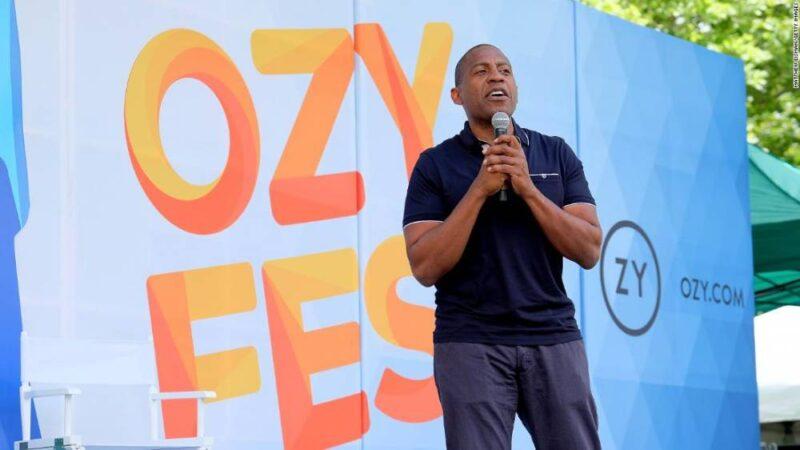New York (CNN Business)Around midnight one Saturday late last year, Eva Rodriguez, 24, had trouble breathing. She lost her vision, started sweating and felt a sharp pain in her stomach. She worried she was having a heart attack.
For two weeks leading up to that night, Rodriguez said recently, she had been working roughly 18 hours a day every day to create the branding for “The Carlos Watson Show,” a talk show named for and hosted by the CEO of Ozy Media. As a creative director at Ozy, for which she’d worked since 2017, she was used to working long hours to accomplish difficult tasks with little lead time. But this was worse. The good news was that it was not a heart attack; ER doctors in Chula Vista, California told her later that Sunday morning it was a panic attack. But it had been bad enough that she needed to take a couple days off work.
“I felt so helpless because I desperately needed to sleep and take time off, but Carlos had expressed how critical my role is to the show,” Rodriguez told CNN Business. “And if I didn’t do this, the show cannot go on.”
“I really didn’t want to let him down,” she continued. “I never want to let him down. If you met him you know he’s a very charismatic leader and he’s not someone you want to let down.” Read MoreRodriguez, whose story was also reported by Forbes this week without her name, said she ended up in a six-week outpatient program for “extremely depressed people to get better.” In December, Rodriguez’s doctor’s office told her that Ozy had asked for documentation to support a doctor’s note she provided. That by itself was not so unusual, but when she emailed her doctor’s office a signed form allowing it to provide the information, she said, she got a call from a nurse who told her that the Human Resources director at Ozy who had called had been “pushy” and aggressive” and asked to review Rodriguez’s medical records. But Ozy did not have someone in that role — the company barely ever did, Rodriguez said. When Rodriguez asked for the person’s name, she said, the nurse replied, “Samir,” which is also the name of the company’s cofounder and chief operating officer, Samir Rao — who is now on leave from Ozy after a New York Times exposé alleged he impersonated a YouTube executive on a call with Goldman Sachs.Ozy’s board of directors announced Tuesday it had hired the law firm Paul, Weiss, Rifkind, Wharton & Garrison LLP to “conduct a review of the company’s business activities,” The Wall Street Journal first reported. The board also said Rao’s leave of absence is “pending the results of the investigation.” The Times wrote that Watson “attributed the incident to a mental health crisis” and shared some details about Rao’s diagnosis. “Samir is a valued colleague and a close friend,” Watson told the Times. “I’m proud that we stood by him while he struggled, and we’re all glad to see him now thriving again.” On Monday, Watson shared an email he sent his staff that referred to the Times story as a “ridiculous hitjob” and once again referred to Rao’s impersonation as a “personal mental health issue.” Watson, Rao and Ozy did not respond to multiple detailed requests for comment from CNN Business.
"I really didn't want to let him down. I never want to let him down. If you met [Carlos Watson] you know he's a very charismatic leader and he's not someone you want to let down."
Rodriguez went back to work for a time after she completed the program. It was not until she tested positive for Covid-19 in February and was asked to work through it that she decided to quit, she said. “It’s like a cult,” Rodriguez said. “I really felt like I would be nothing without them because they had given me so many great opportunities and that I would let them down severely if I ever quit.” Interviews with nine former Ozy employees suggest Rodriguez’s story was not an isolated incident but rather part of a pervasive trend of staffers being worked to the point of exhaustion or worse. Seven of these former employees spoke with CNN Business on condition of anonymity for fear of retribution — some specifically cited concerns that Watson would try to damage their career prospects if he found out they spoke to the press. Several of these former employees said they were angered after reading the Times’ story and seeing that Watson had attributed Rao’s impersonation of a YouTube executive to a mental health crisis and said the company “stood by him,” noting that they’d seen Watson lacking support and empathy for such concerns with other employees in the past.
Why join Ozy
Watson, who previously worked as a host and commentator at CNBC, CNN and MSNBC, launched Ozy in 2013 as a digital media site with ambitions to cover “what’s new and what’s next.” That tagline, which has not really changed, was partly what attracted many reputable journalists to work for the startup. It was an opportunity, they believed, to not chase other outlets’ reporting and instead tell uncovered stories from across the globe. “Carlos and, to a lesser extent, Samir are the most ambitious people you’ve ever met,” said a former staffer. “Their goal was to build the most impactful media company over the next two centuries, a company that was going to survive not just for the short term but be a major brand for years and decades and generations to come.” The former staffer said they knew the idea that Ozy would be able to survive, much less dominate the industry, for nearly that long was questionable. But that type of lofty ambition was emblematic of Watson and the culture he oversaw at Ozy, and employees were motivated by at least some of it.

Refinery29 is reeling from claims of racism and toxic work culture. Employees say it's even worse behind the scenes Ozy’s editorial team did undertake ambitious reporting projects. In 2017, Ozy reporters visited all 50 states for a project called “States of the Nation.” The next year, Ozy announced “Around the World” — a commitment to report three stories in every country. The project was completed, though they did group some smaller countries together. Watson’s editorial ambition was for Ozy’s stories covering ideas and people to be six months ahead of major international and national outlets. In fact, reporters were told that if a major media company — two of the sources said CNN, The New York Times and The Washington Post were the ones they remembered as most often named — had covered a story then they should not pursue it. Like many of Ozy’s other ambitions, though, this might have sounded great, but that didn’t make it realistic. (Nieman Lab’s Joshua Benton reported this week that some of Ozy’s claims to have written about specific famous people before they broke out or were covered elsewhere do not hold water.) “The hope was that we would get appreciation from readers, who liked feeling like they were hearing about stuff that mattered before the mainstream caught on,” said another former staffer. “But I think those of us who were there long enough realized there weren’t all that many readers who cared about that.”

Carlos Watson speaks onstage during OZY FEST 2018 at Rumsey Playfield, Central Park on July 21, 2018 in New York City. The editorial demands were sometimes untenable — or doable only through long hours. In 2014, Ozy raised $20 million from German publishing company Axel Springer, adding to its $5.3 million in seed funding from Laurene Powell Jobs, Ron Conway and others. But former staffers found that, despite raising all that money, the company did not go on big hiring sprees like others in digital media at the time. The former staffer who discussed the hope for appreciation from readers said Ozy was “very nervous to ever truly staff up the way they needed to” because of the massive and multiple rounds of layoffs that other digital media companies went through during the mid- and late-2010s. “They just thought they could keep extracting more and more from the people there,” that former staffer said. “They brought in very talented, motivated, excited people and just used them up.” Watson had high expectations for story output. One former staffer recalled that in the publication’s early days Watson seemed to expect a full-time editorial staff of about four writers and two editors to produce 40 high-quality magazine articles per week. Former staffers found themselves in positions of authority, managing others or even entire departments, while in their 20s. Rodriguez, for example, was hired as a graphic design intern when she was still in college and was promoted to creative director just two years after she graduated. It was an experience that one of the former staffers said “empowered” them and would likely have been unavailable at a legacy media outlet. But the position of authority came with being overworked — they were expected to do that job and the work of their old one at the same time, three of the former staffers said. Former staffers said they often found themselves unable to say no to Watson, whether about a story idea he floated or another assignment he wanted done quickly. “Carlos was a bully,” a former staffer said. “He would do whatever it took to get what he wanted. He did not accept no for an answer.”
Understaffed and overworked
Weekends were not typically for rest at Ozy. Sunday meetings were a regular occurrence. Prior to the pandemic, these meetings were in-person at the office in Mountain View or sometimes required staffers to go to Watson’s home. The time of the meetings was described by former staffers as a moving target. One former staffer recalled a typical kind of thing that would happen would be, for example, that just five minutes before a meeting was supposed to begin, Watson would push it back two hours — and then still end up being 20 minutes late.
"Carlos was a bully. He would do whatever it took to get what he wanted. He did not accept no for an answer."
“What was an hour of your Sunday then turns into like four hours of your Sunday because you have to be around and be available that whole time,” the former staffer said. “You were expected to drop everything,” another former staffer said. That was especially difficult for some employees who did not live close to the office, and not just on weekends. “They would be waiting outside Carlos’ door as his calls pile up. The Caltrain just keeps zooming by and finally it’s eight or nine o’clock and they have to wait another hour,” a third former staffer said. “It’s no surprise people got sick.” Former staffers said they were often tired due to lack of sleep and that employees could sense and see that exhaustion in the office when they were in-person. Two former staffers recalled Watson screaming at them, repeatedly, during their tenures at Ozy. Another former staffer had not been yelled at directly by Watson but heard stories of the habit from others.
Eugene Robinson, a former editor-at-large at Ozy who spoke to the Times for its exposé and said he had been fired earlier this year, also told CNN Business that he’d worked long hours during his nine years at Ozy, and that he’d witnessed that kind of behavior from Watson.”[I was] trying not to lose my mind and avoiding the blast zone of Carlos’ frequently expressed ire,” Robinson told CNN Business. “While the outside world he faced saw glib and charming, those who had to work with him saw a very different face.”
Source: edition.cnn.com

